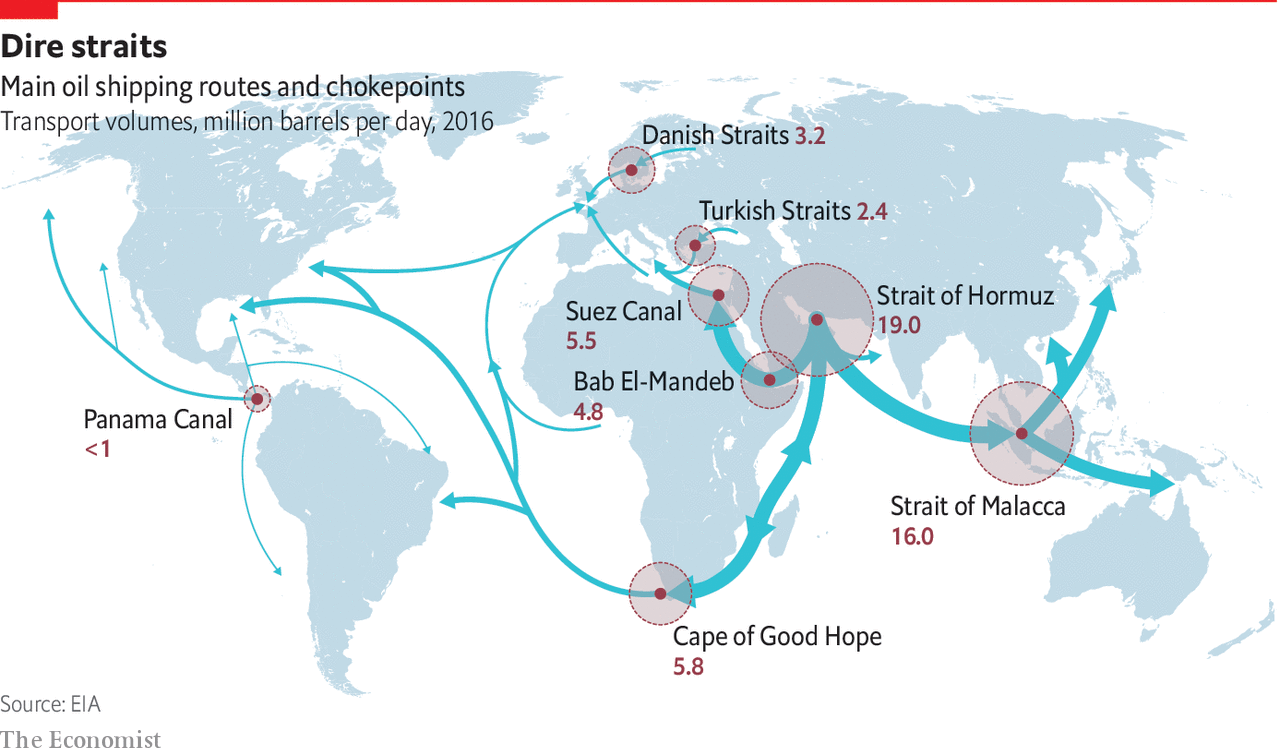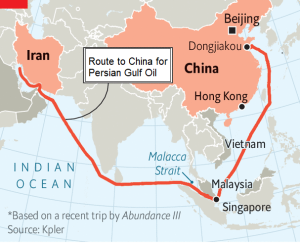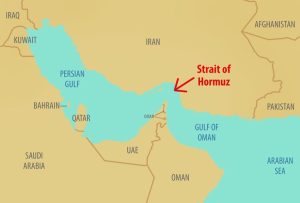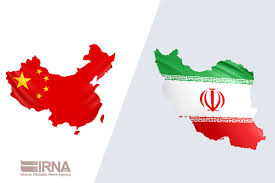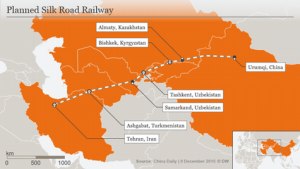Explore how a surge in oil prices or a Strait of Hormuz blockade could reshape China’s entire economy — from industry to shipping, to consumer prices and global trade. A comprehensive, human-centered analysis for maritime professionals, economists, and students.
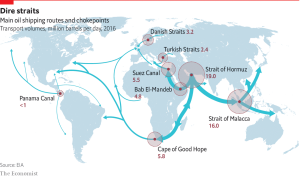
THE STRAIT of Hormuz, a narrow stretch of water connecting the Persian Gulf to the rest of the world’s oceans, has long been recognised as the most important choke-point for global oil supplies. Accounting for about a third of the world’s sea-borne oil (and a fifth of the world’s total oil exports), the strait links oil and gas producers in the Middle East with consumers around the globe, including those in Europe, Asia and America. Image credit: The Economist
Why This Topic Matters for China and the World
If you look at China’s massive economic machine, it is built on an energy-hungry foundation. From manufacturing the smartphones we use every day, to fuelling vast shipping fleets and keeping the lights on for nearly 1.4 billion people, energy is at the core of China’s rise.
But what if a geopolitical spark set off a shock to oil supplies, either by driving oil prices sky-high or by blocking a vital maritime artery like the Strait of Hormuz?
That question is more than a policy puzzle — it could have real consequences for millions of jobs, inflation, and global trade. Nearly 40% of China’s seaborne oil passes through the Strait of Hormuz (UNCTAD, 2024). If this route were blocked, or if oil prices soared due to conflict or sanctions, the entire Chinese economy — already balancing complex transitions — would feel the aftershocks.
In a globally connected world, China’s challenge would also mean everyone’s challenge, from port operators in Rotterdam to manufacturers in Mexico or farmers in Kenya.
China’s Oil Dependency: A Pressure Point
China is the world’s largest oil importer, bringing in over 10 million barrels per day (IEA, 2024). About 70% of that consumption is imported, mainly from the Middle East. Even though China has invested in strategic petroleum reserves and pipeline alternatives, its industries remain deeply dependent on imported oil for:
✅ manufacturing (plastics, chemicals, paints, fertilizers)
✅ transport (trucks, rail, ships, planes)
✅ power generation, especially in coastal industrial clusters
✅ heating and emergency backup for cities
Any sustained oil price surge or shipping disruption would therefore act as a shockwave through the entire Chinese economic structure.
Economic Sectors Most at Risk
Manufacturing and Industry
Think about China’s industrial heartlands — from Guangdong’s electronics assembly lines to Hebei’s steelworks. These are among the largest consumers of oil-derived energy and petrochemicals.
If oil prices jumped 30–50% due to a Hormuz blockade or similar geopolitical crisis, manufacturers would face:
-
higher raw material costs
-
more expensive transport for raw inputs and finished goods
-
shrinking profit margins
-
pressure to pass costs to consumers, risking lower demand
China’s powerful export engine could stall as international buyers look elsewhere for cheaper products.
A 2023 study in Maritime Economics and Logistics found that a 20% oil price rise could raise Chinese manufacturing costs by up to 12% over six months, rippling through the entire global supply chain.
Transport and Logistics
China is also the world’s top container shipping nation and a giant in trucking and rail freight. All these depend on diesel or marine fuels.
Higher oil prices would:
-
push up container rates and road freight tariffs
-
erode competitiveness for Chinese exports
-
strain state-owned and private logistics operators
The knock-on impact? Possibly higher delivery prices for everything from e-commerce goods to essential foods.
Energy and Utilities
China’s power generation has been diversifying (coal, hydro, nuclear, renewables), but diesel and oil-fired backup plants still play a crucial role, especially during peak summer loads.
In the event of a Hormuz disruption, if prices spike or fuel becomes physically unavailable, even emergency backup generation could fail. That might mean:
-
rolling power cuts
-
industrial slowdowns
-
frustrated households
This is not far-fetched. During the 2021 power crunch, factories were rationed to avoid blackouts (Reuters, 2021). A surge in oil costs could spark a similar crisis on a wider scale.
Inflation and Consumer Confidence
Chinese households, like any others, feel energy price surges quickly. Higher oil costs mean higher food prices (because of transport), higher goods costs, and eventually higher services costs.
China’s consumer price index (CPI) is sensitive to oil-linked shocks. According to the People’s Bank of China (2023), a 30% oil price increase could push annual CPI inflation up by 1.2% — a huge jump in a country managing a delicate post-COVID recovery.
Higher inflation usually dents consumer confidence, discouraging spending, and slowing growth.
Strait of Hormuz: The Geopolitical Wildcard
Let’s put this in context. The Strait of Hormuz is only 33 km wide at its narrowest. Yet through it passes:
-
20% of world oil
-
a third of global LNG shipments
-
about 80% of China’s Middle Eastern oil imports
(Encyclopaedia Britannica, 2024)
If the strait were blockaded due to conflict, tanker sabotage, or a military standoff, Chinese buyers would scramble for:
-
West African or Russian cargoes at a premium
-
limited pipeline capacity from Central Asia
-
very expensive spot cargoes
-
longer voyages around the Cape of Good Hope, adding 6,000 nautical miles
Every scenario means paying more for oil, shipping insurance, and security. The result? Higher costs that feed straight into China’s economic bloodstream.
Broader Impacts on Chinese Society
Beyond the cold numbers, there are human stories:
🚛 A long-distance truck driver paying 50% more for diesel, earning less while paying more for food.
👨🏭 A factory worker laid off because the plant cannot afford higher raw material costs.
🏘 A family in Shanghai cutting back on heating or travel because prices surged.
A serious oil crisis would also test China’s social stability — the government has to balance controlling inflation with keeping employment stable, a mission made harder by energy shocks.
China’s Strategic Support for Iran: Ensuring Stability and Countering Rivals
To prevent a disruptive Hormuz Strait blockade, China must actively promote regional stability by strengthening Iran both economically and militarily. This approach serves multiple strategic objectives:
1. Iran’s Strategic Position & Retaliation Risks
- Iran considers a Hormuz blockade a last-resort retaliation against potential U.S. or Israeli military actions.
- A stronger Iran (economically and militarily) reduces Tehran’s reliance on extreme measures, ensuring uninterrupted oil flows critical for China.
2. How China Can Mitigate the Risk
- Economic Support: Expanding trade, investment, and energy deals to reduce Iran’s isolation and economic vulnerabilities.
- Military Cooperation: Modernizing Iran’s defenses to deter foreign aggression, lowering the risk of conflict escalation.
- Diplomatic Mediation: Using China’s influence to de-escalate tensions between Iran and its adversaries, preventing a regional crisis.
3. Aligning with China’s Belt and Road Initiative (BRI) & Countering IMEC
Supporting Iran directly benefits China’s Belt and Road Initiative (BRI), as Iran is a crucial transit hub connecting Asia to Europe. Strengthening Tehran ensures:
- Secure BRI routes, protecting China’s infrastructure investments and trade corridors.
- Countering the India-Middle East-Europe Corridor (IMEC), a U.S.-backed initiative designed to bypass China’s economic influence.
- Expanding China’s geopolitical leverage in the region, reducing Western dominance.
By bolstering Iran’s stability, China not only prevents a Hormuz crisis but also reinforces its own economic and strategic interests in Eurasia.
How China Has Prepared — But With Limits
To be fair, Chinese policymakers know these risks well. In the past decade, China has:
- built strategic petroleum reserves covering up to 90 days of imports (IEA, 2024)
- invested in the China-Russia oil pipeline, Central Asia pipelines, and the China-Pakistan corridor
- boosted its own offshore oil production
- tried to electrify transport and expand renewables
Yet no matter these advances, the scale of China’s energy hunger means oil will stay a pillar for decades. The IEA projects that in 2040, oil will still make up about 40% of China’s energy mix.
So while China has tools to soften a shock, it cannot completely avoid it.
Case Study: The 2019 Tanker Crisis
In mid-2019, attacks on tankers near the Strait of Hormuz briefly jolted oil markets. VLCC charter rates spiked 40% in two weeks, and insurance premiums jumped fivefold (Clarksons Research, 2020). Chinese refiners faced tighter supply, higher costs, and fears of shortages, even though no full blockade happened. That moment showed how fast a regional crisis can ripple across China’s supply chains — affecting not just shipping, but factories, consumers, and even local food prices.
Future Outlook: Can China Break Free?
The long-term question is whether China can truly reduce its vulnerability. A lot will depend on:
✅ investing further in renewables and nuclear
✅ shifting away from internal combustion engines
✅ expanding pipelines across safe routes
✅ cooperating internationally to stabilize the Gulf region
Even so, experts from the World Maritime University (2024) warn that no diversification will ever fully replace the Persian Gulf as a key supplier for China in the next 20 years.
So the risks will stay, and smart crisis planning — including stockpiles, secure maritime routes, and diversified suppliers — will be essential.
Frequently Asked Questions
Why does China import so much oil?
China’s economic engine, including transport, heavy industry, and chemicals, relies heavily on oil — and domestic production cannot keep up with demand.
How would a Strait of Hormuz blockade affect China?
It would choke off a huge portion of China’s oil imports, raising prices and forcing costly detours, with ripple effects on factories, households, and exports.
Can renewables replace oil quickly?
Not yet. China is a renewables leader, but oil still accounts for about 40% of its energy — too big to phase out overnight.
Would global inflation follow a Hormuz crisis?
Very likely. Oil price shocks feed into transport, food, and industrial costs globally, not just in China.
How fast would the Chinese economy feel the effects?
Within days in terms of bunker fuel and transport, and within weeks for broader factory and consumer price impacts.
What is China’s backup plan?
Strategic reserves, pipeline imports, and expanded shipping partnerships — but these can only soften, not fully erase, the crisis.
Conclusion
A surge in oil prices or a blockade in the Strait of Hormuz would shake the foundations of China’s growth model. From industrial production to transport, to consumer prices and social stability, the risks are enormous. While China has made huge progress in diversifying energy sources and building strategic reserves, its dependence on imported oil remains a strategic vulnerability.
For the maritime industry, for economists, for policymakers — this is a powerful reminder that oil is not just a commodity. It is a lifeline that binds China’s economy to distant, often fragile, global shipping lanes. Being prepared — with knowledge, resilience plans, and smarter energy policy — is the only way forward in a world where oil shocks can happen anytime.

